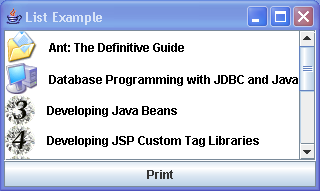Use JList component to display custom objects with ListCellRenderer

/*
Java Swing, 2nd Edition
By Marc Loy, Robert Eckstein, Dave Wood, James Elliott, Brian Cole
ISBN: 0-596-00408-7
Publisher: O'Reilly
*/
// SwingListExample.java
//An example of the JList component in action. This program uses a custom
//renderer (BookCellRenderer.java) to show a list of books with icons of their
//covers.
//
import java.awt.BorderLayout;
import java.awt.Color;
import java.awt.Component;
import java.awt.event.ActionEvent;
import java.awt.event.ActionListener;
import javax.swing.ImageIcon;
import javax.swing.JButton;
import javax.swing.JFrame;
import javax.swing.JLabel;
import javax.swing.JList;
import javax.swing.JPanel;
import javax.swing.JScrollPane;
import javax.swing.ListCellRenderer;
public class SwingListExample extends JPanel {
private BookEntry books[] = {
new BookEntry("Ant: The Definitive Guide", "1.gif"),
new BookEntry("Database Programming with JDBC and Java",
"2.gif"),
new BookEntry("Developing Java Beans", "3.gif"),
new BookEntry("Developing JSP Custom Tag Libraries",
"4.gif"),
new BookEntry("Java 2D Graphics", "4.gif"),
new BookEntry("Java and XML", "5.gif"),
new BookEntry("Java and XSLT", "1.gif"),
new BookEntry("Java and SOAP", "2.gif"),
new BookEntry("Learning Java", "3.gif") };
private JList booklist = new JList(books);
public SwingListExample() {
setLayout(new BorderLayout());
JButton button = new JButton("Print");
button.addActionListener(new PrintListener());
booklist = new JList(books);
booklist.setCellRenderer(new BookCellRenderer());
booklist.setVisibleRowCount(4);
JScrollPane pane = new JScrollPane(booklist);
add(pane, BorderLayout.NORTH);
add(button, BorderLayout.SOUTH);
}
public static void main(String s[]) {
JFrame frame = new JFrame("List Example");
frame.setDefaultCloseOperation(JFrame.EXIT_ON_CLOSE);
frame.setContentPane(new SwingListExample());
frame.pack();
frame.setVisible(true);
}
// An inner class to respond to clicks on the Print button
class PrintListener implements ActionListener {
public void actionPerformed(ActionEvent e) {
int selected[] = booklist.getSelectedIndices();
System.out.println("Selected Elements: ");
for (int i = 0; i < selected.length; i++) {
BookEntry element = (BookEntry) booklist.getModel()
.getElementAt(selected[i]);
System.out.println(" " + element.getTitle());
}
}
}
}
class BookEntry {
private final String title;
private final String imagePath;
private ImageIcon image;
public BookEntry(String title, String imagePath) {
this.title = title;
this.imagePath = imagePath;
}
public String getTitle() {
return title;
}
public ImageIcon getImage() {
if (image == null) {
image = new ImageIcon(imagePath);
}
return image;
}
// Override standard toString method to give a useful result
public String toString() {
return title;
}
}
class BookCellRenderer extends JLabel implements ListCellRenderer {
private static final Color HIGHLIGHT_COLOR = new Color(0, 0, 128);
public BookCellRenderer() {
setOpaque(true);
setIconTextGap(12);
}
public Component getListCellRendererComponent(JList list, Object value,
int index, boolean isSelected, boolean cellHasFocus) {
BookEntry entry = (BookEntry) value;
setText(entry.getTitle());
setIcon(entry.getImage());
if (isSelected) {
setBackground(HIGHLIGHT_COLOR);
setForeground(Color.white);
} else {
setBackground(Color.white);
setForeground(Color.black);
}
return this;
}
}
Related examples in the same category